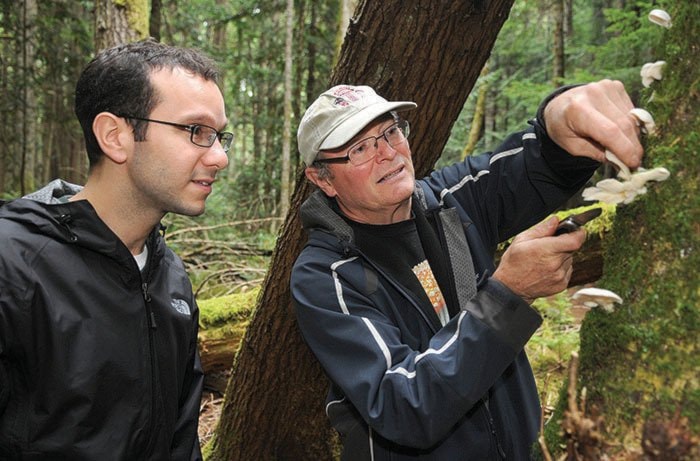Walking through a forest with Kevin Trim is kind of like walking the aisles of a toy store with an excited child. The mushroom hobbyist will one minute be engaged in conversation with me as we walk along a dirt path, and the next run up ahead to show me his find.
“Oh, these need to be picked! Wow, these are good,” he tells me with a grin, as he pulls out a knife to cut a dozen oyster mushrooms from the bark of a tree growing just a few feet off the path. “What a beautiful cluster. Here, you take ‘em with you. You’re going to freak. You’ll really like these.”
(Not even two minutes earlier I had told him how much I dislike the readily-available button mushrooms. “If you’ve only ever experienced store-bought mushrooms, it’s hard to describe how different and delicious some of these really are.”)
Picking the mushrooms is only half the fun. Letting your stomach reap the rewards of your hard work is the other half.
It’s really quite refreshing meeting someone like Trim, whose passion for mushrooms comes out so strong in his words and his behaviour.
On a cool fall morning, he’s taken me to a quiet – but well known – park outside of urban Victoria.
“I should have blindfolded you driving here,” Trim says. That’s the thing about fungi foragers: they’re really territorial.
“If you tell someone about your spot, sooner or later your good spot is not yours anymore in terms of food mushrooms. They’re very specific to where they grow and they’ll come back year after year in the same spot. That’s like your own private little garden if you don’t tell someone,” he says. “I have dozens of spots that I’ve picked for over 10 years and nobody else knows about ‘em.”
I’ve promised Trim that I won’t give away this spot, suffice it to say that we rarely ventured off a well-used path in our hour-and-a-half long walk. During that time, we saw more than two dozen different species of mushrooms and we walked away with some 30-odd pristine mushrooms ready to cook and eat.
Trim’s interest in foraging for mushrooms naturally grew out of his passion for growing his own food.
“They just catch your eye a lot in the woods, and then you think, ‘I wonder what it is. I know you can eat some – I wonder what ones you can eat. How do I find out what mushrooms I can eat?’”
There is no rhyme or reason for determining which mushrooms are edible and which aren’t, Trim says. Edible mushrooms don’t have an across-the-board identifiable characteristic, nor do the toxic ones.
Mushroom picking can be a slow learning process, but ultimately it can become very rewarding.
“You have to know exactly what it is. You can’t fool around with mushrooms,” Trim says. “When you’re going to eat one, you have to be certain, and I mean 100 per cent certain, that it’s the species you think it is. You have to learn each mushroom one at a time. When you put together, ‘It has these certain parts, with that colour, and it grew on this tree,’ then you start to know it must be this and there’s nothing else it can be.”
(His assurance to me that he was 100 per cent certain that what he’d picked for me was edible oyster mushrooms was enough to convince me to try them. I fried them up in a bit of margarine – as per Trim’s recommendation – and they were absolutely delicious. Their mild flavour and seafood-like texture were an easy reintroduction to mushrooms in my life.) Trim, a longtime member of the South Vancouver Island Mycological Society, say the other truly rewarding part of being a forager is getting to be out in nature and truly enjoying what our natural environment has to offer. “It just ain’t a walk in the forest without mushrooms.”
The South Vancouver Island Mycological Society is a very active group of mycologists and mushroom enthusiasts interested in all things fungi. The group meets eight months of year, and also hosts regular events. Membership to SVIMS is $20 per year for the whole family. For more info on membership and events, see svims.ca.
SVIMS hosts its annual mushroom show at the Swan Lake-Christmas Hill Nature Sanctuary on Sunday, Nov. 2. The event is open to the public to come see a wide variety of mushrooms, with experts on hand to provide fun information and help identify fungi you bring in. 10am to 4pm.
